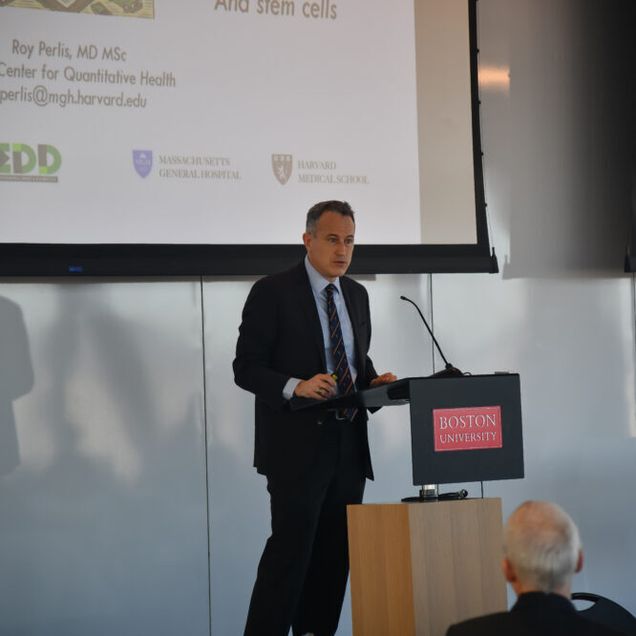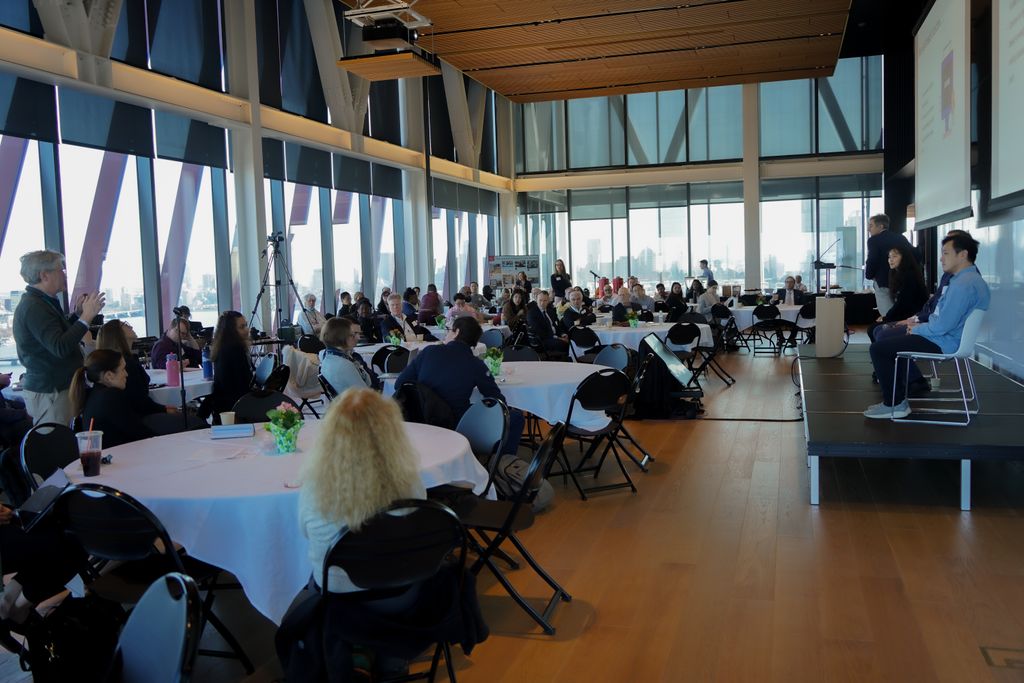BU-CTSI 12th Annual Symposium Looks at AI and Its Impact on Translational Science
The 12th Annual CTSI Translational Science Symposium, held Mar. 19 at BU’s Duan Family Center for Computing & Data Sciences on the Charles River Campus, showcased 10 researchers describing the impact of artificial intelligence (AI), and other cutting-edge technologies, on translational science.
In his opening remarks, David Center, MD, director of the Clinical & Translational Science Institute (CTSI), acknowledged the contributions of the late David Seldin, MD, PhD, in whose memory the symposium is held each year. Seldin passed away in 2015 at the age of 58.
“David Seldin, MD, PhD, former chief of hematology & oncology, was one of the founding core leaders of the BU CTSI. It was his idea to celebrate our accomplishments and provide a forum to highlight our translational science in an annual symposium, each year with a unique theme,” said Center.
 Symposium keynote speaker Roy Perlis, MD, MSc.
Symposium keynote speaker Roy Perlis, MD, MSc.Symposium organizer Christopher Shanahan, MD, PhD, kicked off the presentations by introducing the plenary speaker Roy Perlis, MD, MSc, founding editor-in-chief of JAMA+ AI, director of Massachusetts General Hospital’s Center for Quantitative Health and professor of psychiatry at Harvard Medical School. His lab incorporates machine learning, genomics and cellular models of brain diseas
In a presentation that ranged from the original chatbots of the 1960s to today’s highly sophisticated large language models that are trained on huge datasets and are capable of natural language processing, Perlis was both optimistic and cautionary.
“AI is truly transformative in many ways. It does change how I work as a scientist. It will change how I practice as a physician. It’s already impacting my role as an editor,” Perlis told the audience of 150 attendees. He encouraged them to be critical and skeptical, to use their scientific and clinical skills to evaluate AI and the answers it produces because AI can give wrong answers.
 Research scientists explained their work at the 12th Annual Translational Science Symposium and held in the Duan Family Center for Computing & Data Sciences.
Research scientists explained their work at the 12th Annual Translational Science Symposium and held in the Duan Family Center for Computing & Data Sciences.
Associate Professor of Medicine & Computer Science Vijaya Kolachalama, PhD, spoke about using AI to close what is a widening gap in the number of physicians treating patients with dementia.
“We are developing these multimodal frameworks or models using real world clinical data,” he said, with the goal of having resilient, robust tools that can be used by physicians to screen for dementia and its underlying causes.
Kolachalama was the corresponding author on a 2024 paper published in Nature Medicine describing a multimodal machine learning framework his team created to screen for dementia using commonly collected clinical data. Machine learning is a subfield of artificial intelligence and uses statistical algorithms that can learn from data sets and make predictions.
Using a randomly selected subset of 100 cases, the study showed that neurologist assessments of dementia augmented by his AI model yielded an accurate diagnosis 26% more often than evaluations conducted only by the neurologists.
“Finally, we were able to show that an AI-based solution was actually augmenting clinicians,” Kolachalama said.
Andrew Stokes, PhD, an associate professor of global health in the School of Public Health, discussed machine learning analysis of factors associated with inequities of access to GLP-receptor agonists, weight loss drugs like Ozempic, Rybelsus and Wegovy, among obese adults who don’t have diabetes. Stokes used machine learning models to analyze national health care provider billing data and found that inequities persist in medication access.
“Predictive modeling provides a flexible approach to analyzing thousands of potential features that may be relevant to GLP prescribing in clinical settings.”
Huimin Cheng, PhD, assistant professor of biostatistics at the School of Public Health, presented her work on drug repurposing. Repurposing existing drugs for new uses is faster, cheaper and has less risk than developing new treatments.
Cheng used ChatGPT to search medical literature for SARS-CoV-2 routes of infection and the underlying pathobiology of COVID-10 to design disease treatments, but for her studies the AI model produced multiple errors when compared against searches done by humans.
“Large language models can infer too much without human input”, Cheng found. She hired experts to evaluate the results of a search by a large language model and used their corrections to help the model learn from its mistakes.
“After that we got a better result,” she said. Those results were fed into another model that picked out drugs with the potential for repurposing.
Kayhan Batmanghelich, PhD, assistant professor of electrical and computer engineering and computational biomedicine, talked about his lab’s experience using large language models to detect hidden bias in breast cancer screening. AI does make mistakes that can be hard for the individual specialist or clinician to discern, he said. Batmanghelich and his lab are working on a model that creates a feedback loop, checking for AI mistakes in breast cancer screening, flagging them for the radiologist to review.
“These models can be viewed as a tool that continuously looks at the AI model and pokes it from a different angle to see whether there is a bias, and then transfers it back to the radiologist for further tests,” said Batmanghelich.
Chris Chen, MD, PhD, professor of biomedical engineering at BU’s College of Engineering, director of the Tissue Microfabrication Laboratory and founding director of the Biological Design Center, outlined the decades of progress in building human tissue systems that replicate aspects of organ function, with the goal of eventually being able to build organs themselves for testing and for repair and replacement.
“We really want to build different types of tissues and different tissue organizations because we believe that cells alone typically lose their normal behaviors. It’s only when they are architectured into tissue-like structures that you’re going to rebuild the functionality of certain organs,” said Chen. “We think that you need a combination of basic biology, medicine and engineering to be working together to make these kind of efforts possible.”
Angie Serrano, PhD, assistant professor of vascular biology, spoke on cell regeneration using human induced pluripotent stem cells (iPSC) and zebrafish models. Her work focuses on understanding cellular and molecular mechanisms of neurodevelopment and vasculogenesis in rare diseases caused by mutations in genes of the epigenetic machinery. These genes control how DNA is packed and read without changing the genetic information itself (epigenetics).
“All science is translational. It is our duty to feel comfortable doing basic science, and that will generate datasets that are necessary to train and implement machine learning models to allow more accurate predictions in the rare diseases, translational and clinical science areas where the low number of patients is one of the biggest bottlenecks we have in the field,” said Serrano.
While AI was the focus of the symposium, other presentations dealt with progress in translational science and research.
With 6 to 8 million people in the U.S. suffering from a liver disease, current treatments are focused on eliminating the underlying cause or liver transplant. There is only one FDA-approved drug to alleviate chronic liver disease, said Valerie Gouon-Evans, PhD, PharmD, associate professor of medicine in gastroenterology and director of Boston University Liver Biologist (BULB) program.
To address this clinical gap, the Gouon-Evans Lab developed strategies to harness liver regeneration by improving the naturally occurring liver repair mechanisms. The laboratory specifically delivers regenerative factors into the liver by treating mice with mRNA encapsulated in lipid nanoparticles, a platform widely used for the recently developed mRNA-based COVID-19 vaccines.
“This will allow the generation of healthy hepatocytes, which are the most functional cells in the liver,” said Gouon-Evans. “What we hope is that this platform can help alleviate acute and chronic liver disease.”
Finn Hawkins, MBBCh, associate professor of medicine and director of the Interstitial Lung Disease clinic at Boston Medical Center, investigates lung regeneration using induced pluripotent stem cells (iPSCs). These are cells from blood samples that are turned into embryonic stem cells and then differentiated into lung epithelial cells that can be used for both detection and potentially treatment of diseases like Primary Ciliary Dyskinesia (PCD) and cystic fibrosis.
“Instead of waiting for end-stage lung disease, we hope to transplant the right cell early enough in the disease course to prevent the development of PCD or cystic fibrosis,” said Hawkins.
Kim Vanuytsel, PhD, MS, a stem cell biologist and assistant professor, is head of the Vanuytsel Lab at the Center for Regenerative Medicine. She also works with iPSCs, investigating sickle cell disease.
“Thanks to the recent advancements in gene therapy it is now possible to treat sickle cell disease patients with their own therapeutically modified stem cells, and this is a curative approach,” said Vanuytsel. But significant barriers to treatment exist for most patients, including eligibility and cost.
“This is why we need to keep investing in the development of treatments that can alleviate symptoms for patients globally, who might not be eligible or reside in lower resource settings,” she said. Using iPSCs, her lab can capture how a specific patient will respond to various treatments, allowing for patient-specific recommendations for treatment.
“This SCD (sickle cell disease) iPSC platform expands the preclinical toolbox, adding genetic diversity as an important and often overlooked component in drug discovery and validation,” said Vanuytsel.
A traditional part of the annual symposium is a scientific posters competition. This year over 40 posters were presented from over a dozen BU schools, colleges and departments. There was a first-place tie in the competition between Kevin Chen “Transplanting Airway Basal Cells to Rescue CFTR Function” and Varuna Jasodanand, “AI for Biological Alzheimer’s Disease and Staging” and a tie for third place between Katheryn Ann Odamah, “Investigation of Rescue Strategies for Nexmif-dependent Autism Spectrum Disorder”, and Braden Pate, “Sickle Cell Disease Specific iPSC Platform as a Preclinical Screening Tool”.
Find videos of the symposium on the CTSI channel.